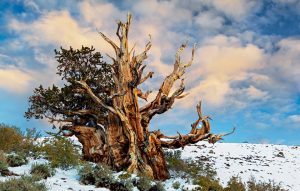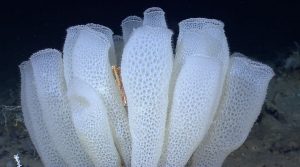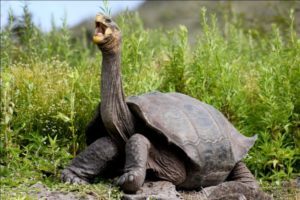Podcast: Play in new window | Download (Duration: 15:52 — 18.5MB)
Thanks to Oz from Las Vegas for suggesting this week’s topic!
Further reading:
Bobi, the supposed ‘world’s oldest dog’ at 31, is little more than a shaggy dog story
Greenland sharks live for hundreds of years
Scientists Identify Genetic Drivers of Extreme Longevity in Pacific Ocean Rockfishes
Scientists Sequence Chromosome-Level Genome of Aldabra Giant Tortoise
Giant deep-sea worms may live to be 1,000 years old or more
A Greenland shark [photo by Eric Couture, found at this site]:
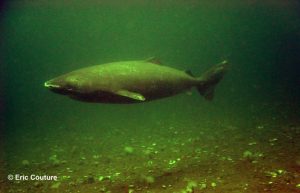
The rougheye rockfish is cheerfully colored and also will outlive us all:
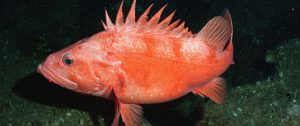
An Aldabra tortoise all dressed up for a night on the town:
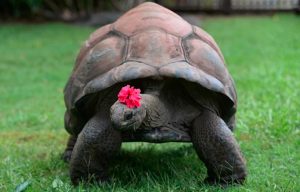
Escarpia laminata can easily outlive every human. It doesn’t even know what a human is.
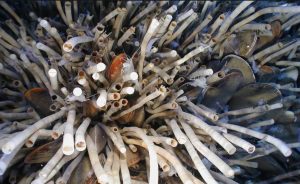
Show transcript:
Welcome to Strange Animals Podcast. I’m your host, Kate Shaw.
This week we have a great suggestion by Oz from Las Vegas. Oz wanted to learn about some animals that will outlive us all, and gave some suggestions of really long-lived animals that we’ll talk about. We had a similar episode several years ago about the longest lived animals,where for some reason we talked a lot about plants, episode 168, but this is a little different.
But first, a quick correction! Last week we talked about the dodo and some of its relations, including the Nicobar pigeon. I said that the Nicobar pigeon lived in the South Pacific, but Pranav caught my mistake. The Nicobar pigeon lives in the Indian Ocean on the Nicobar Islands, which I should have figured out because of the name.
Anyway, back in the olden days when I was on Twitter all the time, I came across a tweet that’s still my absolute favorite. Occasionally I catch myself thinking about it. It’s by someone named Everett Byram who posted it in January 2018. It goes:
“DATE: so tell me something about yourself
“ME: I am older than every dog”
Not only is it funny, it also makes you thoughtful. People live a whole lot longer than dogs. The oldest living dog is a chihuahua named Spike, who is 23 years old right now. A dog who was supposed to be even older, 31 years old, died in October of 2023, but there’s some doubt about that particular dog’s actual age. Pictures of the dog taken in 1999 don’t actually look like the same dog who died in 2023.
The oldest cat who ever lived, or at least whose age is known for sure, died in 2005 at the age of 38 years. The oldest cat known who’s still alive is Flossie, who was born on December 29th, 1995. If your birthday is before that, you’re older than every cat and every dog.
The oldest human whose age we know for sure was Jeanne Calment, who died in 1997 at the age of 122 years. We talked about her in episode 168. The oldest human alive today, as far as we know, is Maria Branyas, who lives in Spain and will turn 117 years old on her next birthday in March 2024.
It’s not uncommon for ordinary people to live well into their 90s and even to age 100, although after you reach the century mark you’re very lucky and people will start asking you what your secret for a long life is. You might as well go ahead and make something up now to tell people, because it seems to mainly be genetics and luck that allow some people to live far beyond the lives of any dog or cat or most other humans. Staying physically active as you age also appears to be an important factor, so keep moving around.
But there are some animals who routinely outlive humans, animals who could post online and say “I am older than every human” and the others of its species would laugh and say, “Oh my gosh, it’s true! I’m older than every human too!” But they don’t have access to the internet because they are, for instance, a Greenland shark.
We talked about the Greenland shark in episode 163. It lives in the North Atlantic and Arctic Oceans where the water is barely warmer than the freezing point. It can grow up to 23 feet long, or 7 meters, with females being larger than males. Despite getting to such enormous sizes, it only grows one or two centimeters a year, and that was a clue for scientists to look into how old these sharks can get.
In 2016, a team of scientists published a study about how they determined the age of Greenland sharks that had been accidentally caught by fishing nets or that had otherwise been discovered already dead. The lenses inside vertebrate eyeballs don’t change throughout an animal’s life. They’re referred to as metabolically inactive tissue, which means they don’t grow or change as the animal grows. That means that if you can determine how old the lens is, you know when the animal was born, or hatched in the case of sharks.
In the past, scientists have been able to determine the age of dead whales using their eye lenses, but the Greenland shark was different. It turns out that the shark can live a whole lot longer than any whale studied, so the scientists had to use a type of carbon-14 dating ordinarily used by archaeologists.
The Greenland shark may be the oldest-living vertebrate known. Its life expectancy is at least 272 years, and probably closer to 500 years. Individual sharks can most likely live much longer than that. It’s not even mature enough to have babies until it’s about 16 feet long, or 5 meters, and scientists estimate it takes some 150 years to reach that length. Females may stay pregnant for at least 8 years, and maybe as long as 18 years. Babies hatch inside their mother and remain within her, growing slowly, until they’re ready to be born.
The Greenland shark is so big, so long-lived, and lives in such a remote part of the ocean that taking so long to reproduce isn’t a problem. Its body tissues contain chemical compounds that help keep it buoyant so it doesn’t have to use very much energy to swim, and which have a side effect of being toxic to most other animals. Nothing much wants to eat the Greenland shark. But it is caught by accident by commercial fishing boats, with an estimated 3,500 sharks killed that way every year. Scientists hope that by learning more about the Greenland shark, they can bring more attention to its plight and make sure it’s protected. There’s still a lot we don’t know about it.
At least one species of whale does live much longer than humans. In 2007, researchers studying a dead bowhead whale found a piece of harpoon embedded in its skin. It turned out to be a type of harpoon that was manufactured between 1879 and 1885. After that, scientists started testing other bowhead whales that were found dead. The oldest specimen studied was determined to be 211 years old when it died, and it’s estimated that the bowhead can probably live well past 250 years if no one harpoons it and it stays healthy. It may be the longest-lived mammal. It has a low metabolic rate compared to other whales, which may contribute to its longevity.
Most small fish don’t live very long even if nothing eats them. Rockfish, for instance, only live for about 10 years even if they’re really lucky. Well, most rockfish. There is one species, the rougheye rockfish, that lives much, much longer. Its lifespan is at least 200 years old.
The rougheye rockfish has a lot of other common names. Its scientific name is Sebastes aleutianus. It can grow over 3 feet long, or 97 cm, and is red or orangey-red. It lives in cold waters of the Pacific, where it usually stays near the sea floor. It eats other fish along with crustaceans.
Naturally, scientists are curious as to why the rougheye rockfish lives so long but its close relations don’t. In 2021 a team of scientists published results of a genetic study of the rougheye rockfish and 87 other species. They discovered a number of genes associated with longevity, along with genes controlling inflammation that may help the fish stay healthy for longer.
The rougheye rockfish only evolved as a separate species of rockfish about ten million years ago. Because the longest-living females lay the most eggs, the genes for longevity are more likely to be passed on to the next generation, which means that as time goes on, lifespans of the fish overall get longer and longer. The rougheye also isn’t the only species of rockfish that lives a long time, it’s just the one that lives longest. At least one other species can live over 150 years and quite a few live past 100 years.
Another animal that can easily outlive humans is the giant tortoise, which we talked about in episode 95. Giant tortoises are famous for their longevity, routinely living beyond age 100 and sometimes more than 200 years old. The oldest known tortoise is an Aldabra giant tortoise that may have been 255 years old when it died in 2006. The Aldabra giant tortoise is from the Aldabra Atoll in the Seychelles, a collection of 115 islands off the coast of East Africa.
Scientists studied the Aldabran tortoise’s genetic profile in 2018 and learned that in addition to genes controlling longevity, it also has genes that control DNA repair and other processes that keep it healthy for a long time.
Oz also suggested the infinite jellyfish, also called the immortal jellyfish. An adult immortal jelly that’s starving or injured can transform itself back into a polyp, its juvenile stage. We talked about it in episode 343 in some detail, which was recent enough that I won’t cover it again in this episode. Scientists are currently studying the jelly to learn more about how it accomplishes this transformation and how long it can really live.
So far all the animals we’ve talked about, except the immortal jellyfish, are vertebrates. It’s when we get to the invertebrates that we find animals with the longest lifespans. The ocean quahog, a type of clam that lives in the North Atlantic Ocean, grows very slowly compared to other clams, and populations that live in cold water can live a long time. Sort of like tree rings, the age of a clam can be determined by counting the growth rings on its shell, and a particular clam dredged up from the coast of Iceland in 2006 was discovered to be 507 years old. Its age was double-checked by carbon-14 dating of the shell, which verified that it was indeed just over 500 years old when it was caught and died. Researchers aren’t sure how long the quahog can live, but it’s a safe bet that there are some alive today that are older than 507 years, possibly a lot older.
The real long-lived animals are very simple ones, especially sponges and corals. Some species of both can live for thousands of years. Various kinds of mollusks and at least one urchin can live for hundreds of years.
It’s probable that there are lots of other animals that routinely outlive humans, we just don’t know that they do. Scientists don’t always have a way to check an animal’s age, or they don’t think to do so while studying an organism. There are also plenty of animals that we just don’t know exist, especially ones that live in the ocean. For example, a species of tube worm named Escarpia laminata wasn’t even discovered until 1985, and it wasn’t until 2017 that scientists realized it lived for hundreds or even thousands of years.
The tube worm doesn’t have a common name, since it lives in the deepest parts of the Gulf of Mexico around what are called cold seeps, so no one ever needed to refer to it until it was discovered by scientists. A cold seep isn’t actually cold, it just isn’t as hot as a hydrothermal vent. In a cold seep, oil and methane are released into the ocean from fissures in the earth’s crust. Life forms live around these areas that live nowhere else in the world.
Many tube worms can grow quite long and can live over 250 years, with the giant tube worm growing almost 10 feet long, or 3 meters. Escarpia laminata is smaller, typically only growing about half that length. In a study published in 2017, a team of scientists estimated that it routinely lives for 250 to 300 years and potentially much, much longer. A tube worm doesn’t actually eat; instead, it forms a symbiotic relationship with bacteria that live in its body. The bacteria have a safe place to live and the tube worm receives energy from the bacteria as they oxidize sulfur released by the cold seeps. The tube worm, in other words, lives a stress-free life with a constant source of energy, and nothing much wants to eat it. The limit to its life may be the limit of the cold seeps where it lives. Cold seeps don’t last forever, although many of them remain active for thousands of years.
Humans are probably the longest-living terrestrial mammal. This may not seem too impressive compared to the animals we’ve talked about in this episode, but our lives are a whole lot more interesting than a tube worm’s.
You can find Strange Animals Podcast at strangeanimalspodcast.blubrry.net. That’s blueberry without any E’s. If you have questions, comments, or suggestions for future episodes, email us at strangeanimalspodcast@gmail.com. We also have a Patreon at patreon.com/strangeanimalspodcast if you’d like to support us for as little as one dollar a month and get monthly bonus episodes.
Thanks for listening!
